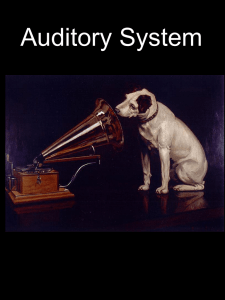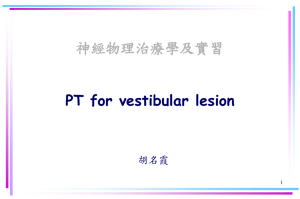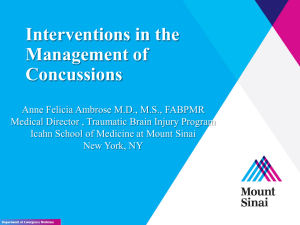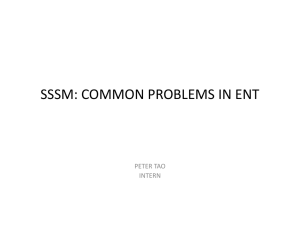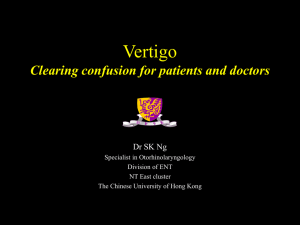Gacek--Viral Neuropathies of the Temporal bone--
advertisement
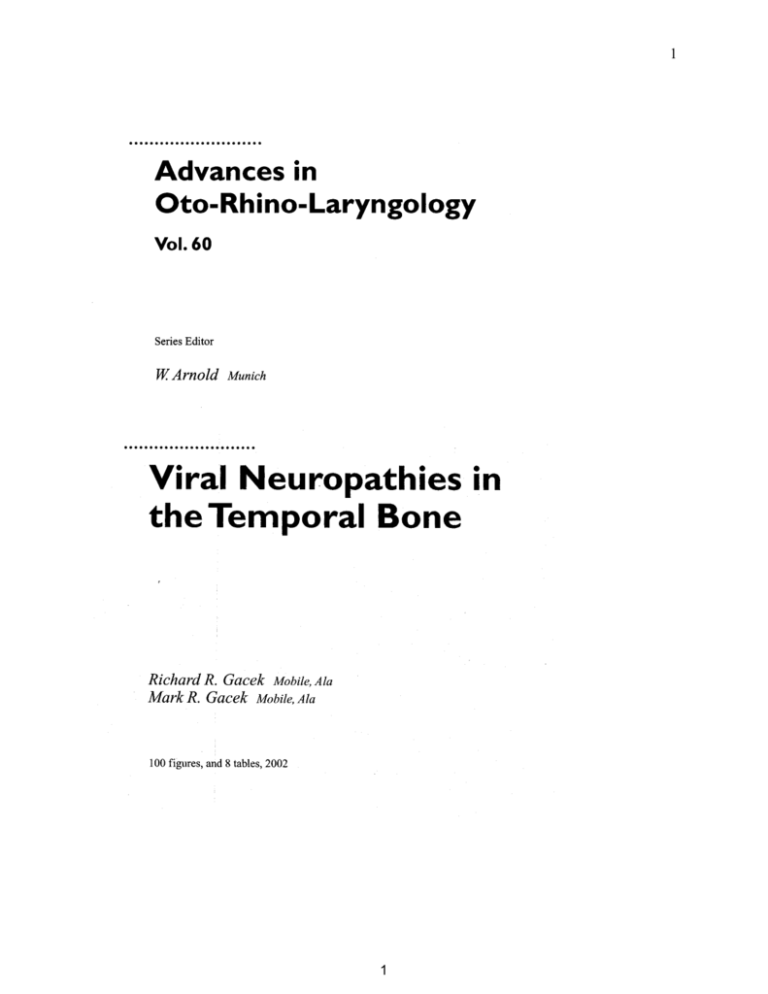
1 1 2 2 3 Classification of Recurrent (Viral) Vestibulopathies (Gacek & Gacek 2002) The syndromes of Vestibular neuronitis, Benign Positional Vertigo (BPV), and Menière’s disease are clinical expressions of vestibular ganglionitis probably caused by the alpha Herpes virinae family. Several factors may determine the “face” presented in individual patients. These are 1) the amount of virus present (viral load), 2) the virus type and strain, 3) the location and number of affected vestibular ganglion cells, and 4) host resistance. It is possible that other forms of recurrent vertigo are expressions of vestibular ganglionitis. Gacek & Gacek: Anterograde virus strain (hearing preserved) Superior vestibular ganglionitis (vestibular neuritis, vestibular Menière disease) Inferior vestibular ganglionitis (BPV = benign positional vertigo) Superior and inferior vestibular ganglionitis (vestibular neuritis and BPV) 3 4 Gacek & Gacek: Retrograde virus strain (hearing affected) Superior vestibular ganglionitis (Menière disease, neurolabyrinthitis) Subtype, utricular ganglionitis (Tumarkin’s otolithic crisis) Superior and inferior vestibular ganglionitis (Menière disease and BPV) 4 5 Ear Nose Throat Journal 81:785-89, 2002: 5 6 2003: “Pathology of Benign Paroxysmal Positional Vertigo Revisited” Prof Richard Gacek Boston, Annals of Otology, Rhinology & Laryngology, Volume 112, (7): 574-582, Abstract: The pathophysiology of benign paroxysmal positional vertigo (BPPV) is not completely understood. Although the concept of degenerated otoconia transforming the posterior canal (PC) crista into a gravitysensitive sense organ has gained popular support, several temporal bone (TB) series have revealed similar depositis in normal TBs, suggesting they are a normal change in the aging labyrinth. Furthermore, some TBs from patients with BPPV do not contain particles in the posterior canal. Five TBs from patients with BPPV were studied quantitatively and alitatively. A small cupular deposit was found in 1 TB, while none was seen in the other 4 TBs. The major pathological changes were 1) a 50% loss of ganglion cells in the superior vestibular division of all 5 TBs, and 2) a 50% loss of neurons in the inferior division of 3 TBs, and a 30% loss in 2 TBs that contained abnormal saccular ganglion cells. These observations support a concept in the pathophysiology of BPPV that includes loss of inhibitory efect of otolith organs on canal sense organs. Conclusion: Observations in 5 temporal bones from patients with posterior canal BPPV suggest that the pathophyisological mechanism responsible for a position-induced vestibular-ocular response in this disorder is neural, rather than mechanical stimulation of the sense organ. Loss of the inhibitory action of otolith organs on canal activation caused by degeneration of otolith neurons (saccular, utricular) is a possible explanation of the brief canal response induced by the positional stimulus. - --------------------------------------------------------------- Menière’s Disease is a Viral Neuropathy Richard Gacek: ORL 71:78-86 2009 Morphological and clinical evidence supports a viral neuropathy in Menière disease. Quantitative examination of 11 sectioned temporal bones from 8 patients with a history of Men. Disease revealed a significant loss of vestibular ganglion cells in both the endolymph hydropic and non-endolymph hydropic ears. Transmission electron microscopy of vestibular ganglion cells excised from a patient with Menière disease revealed viral particles enclosed in transport vesicles. Antiviral treatment controlled vertigo in 73 of 86 patients with vestibular neuronitis (85%) and 32 of 35 patients with Menière disease (91%). The high (90%) rate of vertigo control with orally administered antivirals provide clinical experience 6 7 Abstract Objective: To provide a road map of the vestibular labyrinth and its innervation leading to a place principle for different forms of vertigo. Method: The literature describing the anatomy and physiology of the vestibular system was reviewed. Results: Different forms of vertigo may be determined by the type of sense organ, type of ganglion cell and location in the vestibular nerve. Conclusion: Partial lesions (viral) of the vestibular ganglion are manifested as various forms of vertigo. 7 8 8 9 9 10 10 11 11 12 12 13 -------------------------- 13 14 Bloemfontein, South Africa, April 1997 Proposal for a New Classification of Episodic Vertigo based on Symptoms Dr Adour and Dr Hamersma propose the following new classification for episodic attacks of vertigo which constitute the differential diagnosis of the Syndrome of Menière: EPISODIC VERTIGO Episodic Vestibulopathy: Recurrent attacks of rotational dizziness (vertigo) without any auditory symptoms, not caused by positional factors, which usually last from 5 minutes to 48 hours (also called vestibular Menière) and occasionally for many days (also called vestibular neuronitis) – 1. Caused by replication of the HSV-1 virus, i.e. Polyganglionitis Episodica; 2. Vertige de l’enfance, and 3. Vestibular epilepsy Episodic Cochleo-Vestibulopathy: Recurrent attacks of vertigo plus auditory symptoms, which usually last from 5 minutes to 48 hours (also called classic Menière disease), occasionally for many days (protracted attack), including the very severe form also called viral labyrinthitis, and those which develop in previously traumatised and deafened ears (also called secondary endolymphatic hydrops) - 1. Caused by replication of the HSV-1 virus, i.e.Polyganglionitis Episodica; 2. Autoimmune inner ear disease, and 3. Cogan’s disease. - ------------------------ 14 15 Menière’s Disease is a Viral Neuropathy Gacek R.R. Department of otolaryngology-Head and Neck Surgery, UMass Memorial Medical Center, Worcester, MA. Presented at the Bárány Society Meeting in Kyoto, Japan on March 31, 2008. Objective: To present evidence which supports a viral vestibular neuropathy as the cause of Meniėre’s Disease (MD) Methods: Evidence from three sources was reviewed. 1. Quantitative and qualitative examination of eleven (11) sectioned temporal bones (TB) from eight patients with a history of MD. 2. Transmission electron microscopic (TEM) examination of the Vestibular ganglion excised from a patient with MD. 3. Clinical results of antiviral therapy in 121 patients with recurrent vertigo. Eighty-six patients with vestibular neuronitis (VN) and thirty-five with MD were treated with oral acyclovir over a 34 month period. Results: 1. TB series: Endolymphatic hydrops (EB) was present in 9 out of 11 TB. Vestibular cistern fibrosis was observed in 6 out of the 11 TB. Focal axonal degeneration in the vestibular nerve and degenerated meatal ganglion cells was present in all TB. One TB contained epithelial cells with a large intranuclear inclusion body in the vestibular cistern. These epithelial cells were mixed with microcystic structures characteristic for cytomegalo virus (CMV) labyrinthitis. All eleven vestibular ganglion cell counts revealed a significant loss compared to normal values. 2. The vestibular ganglion: The vestibular ganglion excised to control vertigo in a 45 year old female with MD was examined by TEM. Viral capsids enclosed in transport vesicles were observed in the cytoplasm of ganglion cells (Fig. 1). Margination of nuclear chromatin was consistent with viral reactivation. 15 16 3. Antiviral therapy: One hundred forty-seven (147) consecutive patients with MD and VN were treated with oral acyclovir from April 2004 to February 2007. There were 94 females and 53 males. Ages ranged from 23 to 87 years (avg. 53 years). Twenty-six patients were lost to follow-up. Vertigo was controlled in 73 of 86 patients with VN (85%), vertigo control was achieved in 32 of 35 patients with MD (91%). Conclusion: Morphological changes in the vestibular nerve and results following antiviral therapy supports the concept of a viral vestibular neuropathy in MD. Fig. 1: Transmission electron microscopy of vestibular ganglion cell in MD. There are several viral capsids enclosed in transport vesicles from the Golgi network. (arrows). Discussion following presentation: The author answered a question on antiviral therapy and stated that oral acyclovir 800 mg t.i.d. for 3 weeks was given, then 800 mg b.i.d. for 4 weeks, and then 800 mg daily 16


